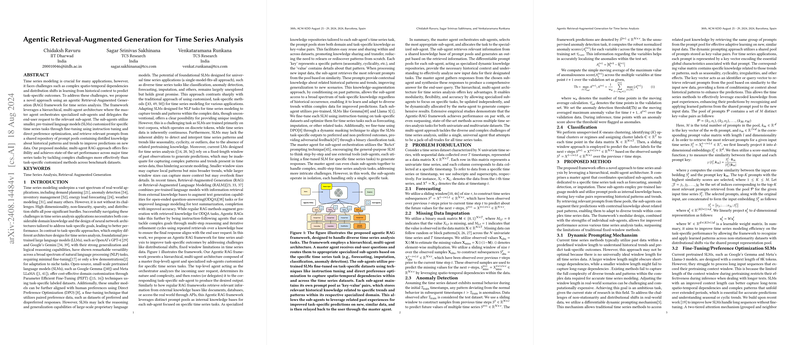Agentic Retrieval-Augmented Generation for Time Series Analysis: An Expert Overview
Introduction
Time series analysis is a fundamental aspect of diverse scientific and engineering applications, such as demand forecasting, anomaly detection, and weather prediction. Nevertheless, these models encounter significant hurdles, including high dimensionality, non-linearity, data sparsity, and shifts in data distribution. The paper "Agentic Retrieval-Augmented Generation for Time Series Analysis" proposes a novel Agentic Retrieval-Augmented Generation (RAG) framework to address these challenges by employing a hierarchical, multi-agent architecture. This summary presents an expert analysis of the methods, results, and potential implications of the methodology.
Proposed Methodology
The Agentic RAG framework distinguishes itself by leveraging a hierarchical structure composed of a master agent and specialized sub-agents. These sub-agents are equipped with smaller, pre-trained LLMs (SLMs) fine-tuned for specific time series tasks. The critical innovations include:
- Hierarchical Multi-Agent Architecture:
- Master Agent: Functions as an orchestrator, delegating incoming user requests to appropriate sub-agents.
- Sub-Agents: Specialized in distinct tasks (e.g., forecasting, anomaly detection), utilizing pre-trained SLMs that have been fine-tuned using Parameter Efficient Fine-Tuning (PEFT) techniques and Direct Preference Optimization (DPO).
- Retrieval-Augmented Generation:
- Each sub-agent retrieves knowledge from a shared repository of prompt pools containing historical patterns and trends.
- This mechanism taps into past knowledge, allowing enhanced generalization and more accurate predictions.
- Dynamic Prompting Mechanism:
- The framework employs a dynamic prompting technique that adjusts to the nature of new input data, addressing issues with fixed-length historical windows in time series analysis.
Experimental Results
The authors conducted empirical evaluations on multiple benchmark datasets for different time series tasks, achieving state-of-the-art performance. Key results include:
- Forecasting:
Agentic-RAG variants (SelfExtend-Gemma-2B, Gemma-7B, and Llama 3-8B) consistently outperformed traditional models across datasets such as PeMSD3, PeMSD4, PeMSD7, and METR-LA. For example, on the PeMSD3 dataset, the Llama 3-8B variant achieved a mean absolute error (MAE) of 13.01, significantly lower than the best baseline (AGCRN) which had an MAE of 15.57.
- Anomaly Detection:
The framework demonstrated remarkable precision, recall, and F1-scores on datasets like SWaT and WADI. The precision for the SWaT dataset with the Agentic-RAG W/Llama 8B was 99.47%, far surpassing other advanced methods like GRELEN, which achieved a precision of 95.60%.
- Missing Data Imputation:
The framework showed resilience to varying degrees of data incompleteness. Under scenarios with 20% block missing data, the model maintained lower RMSE and MAE values compared to classical models, outperforming them even with substantial data gaps.
Implications and Future Directions
The Agentic RAG framework presents a highly flexible and modular approach to tackling complex time series analysis tasks. The ability to dynamically retrieve historical context and adapt to new data distributions is a significant departure from traditional fixed-window methods, providing strengthened predictive accuracy.
Practical Implications:
- Improved Forecasting and Decision-Making:
- Enhanced forecasting accuracy translates to better inventory management, energy load forecasting, and financial planning.
- Robustness in Anomaly Detection:
- Superior anomaly detection capabilities augur well for industries relying on early fault detection, such as manufacturing and cybersecurity.
Theoretical Implications:
- Advancements in Time Series Analysis:
- The hierarchical, multi-agent approach could inspire new architectures that blend diverse models aimed at specialized tasks.
- Integration with LLMs:
- The adaptation of SLMs for time series tasks merges natural language processing prowess with time series modeling, broadening the scope for future research.
Future Developments:
- Scalability and Computational Efficiency:
- Future iterations could explore more lightweight models tailored for edge computing applications.
- Cross-Domain Adaptability:
- Extending the application of the RAG framework across different domains for broader applicability and efficiency.
- Enhanced Retrieval Mechanisms:
- Further refinement in retrieval mechanisms to handle more complex forms of data dependencies and non-stationarity.
Conclusion
The Agentic RAG framework introduces a sophisticated and versatile approach for time series analysis, integrating hierarchical multi-agent systems and robust retrieval mechanisms. By optimizing pre-trained LLMs for time series-specific tasks using fine-tuning and direct preference optimization, this framework sets new benchmarks in accuracy and adaptability across multiple tasks. As research progresses, the principles underlying this framework have the potential to redefine standards in time series modeling and beyond.
